How to Build a Barbed Wire Fence (9 Steps)
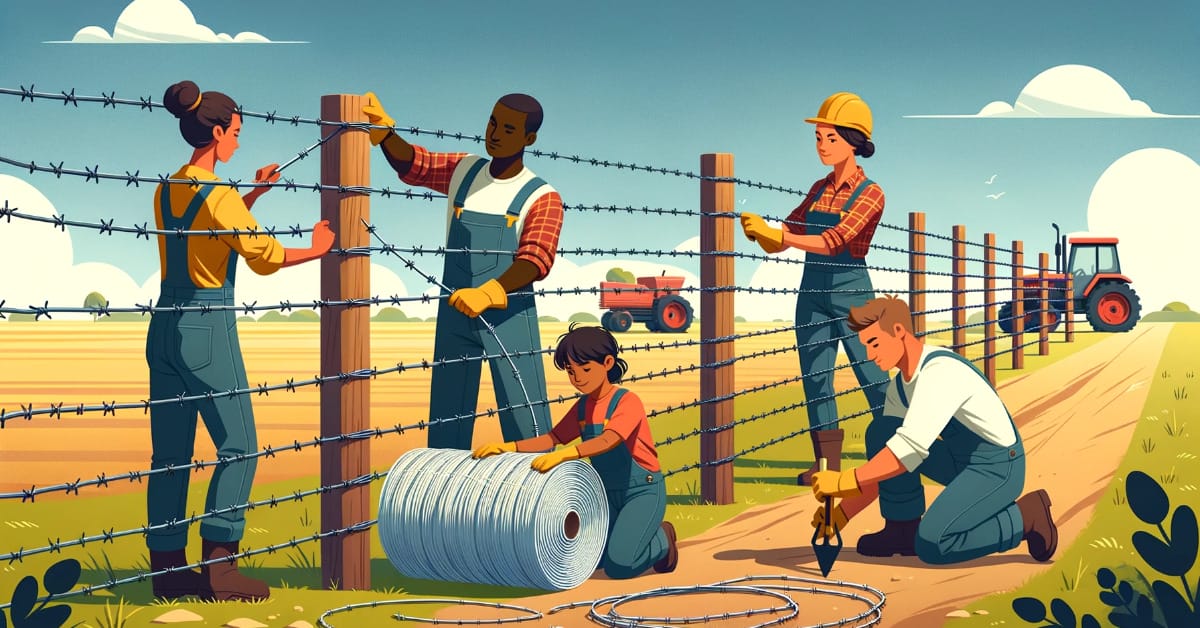
If you need to build a barbed wire fence, this article is for you. We’ll go through all the requirements and some recommendations before explaining the procedure, where I’ll focus more on the wiring part. Safety advice is included.
When building a barbed wire fence, design and layout the type you want. Then, dig holes for the posts, secure them inside the ground, and mark points for the barbed wire strands. Be very careful when handling barbed wire and attaching it to the posts.
I’ve explained the whole procedure in detail with illustrations below.
Requirements and Recommendations
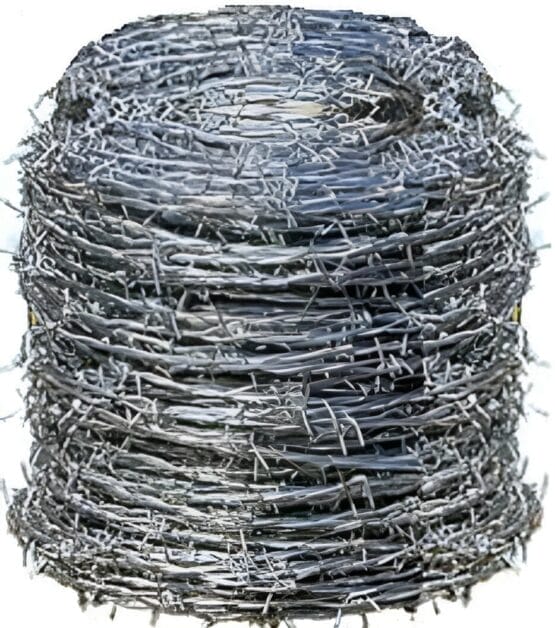
You will need the following items, tools, and materials to build a barbed wire fence:
| Large Items | Tools and Instruments | Materials |
• Posts (wooden or steel)• Lumbar (for the rails)• Wire (barbed or welded, galvanized) | • Post hole digger• Power drill• Circular saw• Tape measure• Spirit level• Hammer• Optional: A wire grab device and “come along” • Crimp tool | • Screws• Brackets (L type)• Fence roll• Hinges• Gate latches• Concrete• Gravel• Crimp sleeve • Corner braces • D-shaped hooks |
Barbed Wire Accessories
In addition to the above, you may also need barbed wire accessories depending on the length and design of your barbed wire fence.
For example, you might create a vertical fence or one with an angled top for the barbed wire portion to make it less visible. Various barbed wire accessories may be available at your local DIY store. Some are shown below. I recommend only using accessories made with galvanized steel.
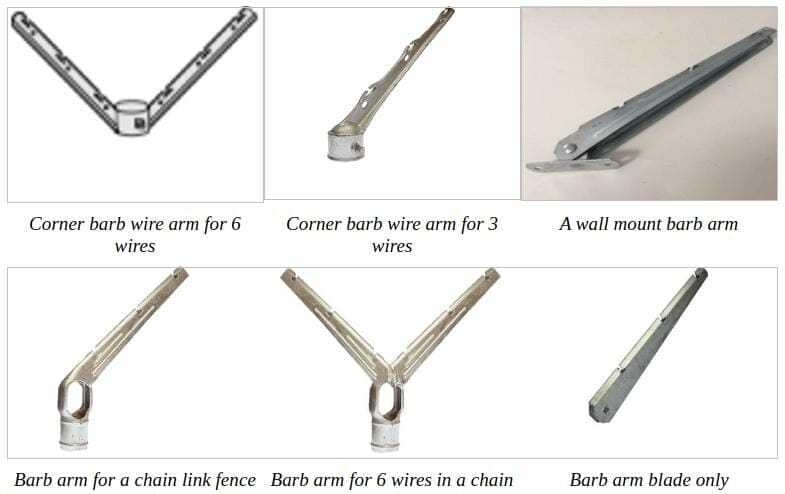
Design
I’ve included a sample if you need inspiration to design your barbed wire fence.
Sizes
The dimensions of the barbed wire fence depend on your particular needs and preferences.
But if you’re unsure or would like a general guide, apply the dimensions below for a simple vertical barbed wire fence. Note that:
- The bottom of each post is buried about one foot underground. Depending on your fence’s height, increase it to 2’ to 3’ for a more solid footing.
- The posts (7’ high, shown below) are about 6 to 8 feet apart. If you have long sides, you can stretch the spaces to between 12 and 18 feet with longer posts (buried deeper, too).
- The barbed wire portion covers about 2 feet of the top part of each post, which you can extend to cover more of the lower portion as required.
- The vertical space between each barbed wire should not exceed about 6”.
- Optionally reinforce the bottom 4-foot portions covered with wire mesh with extra pipes placed diagonally (not shown).
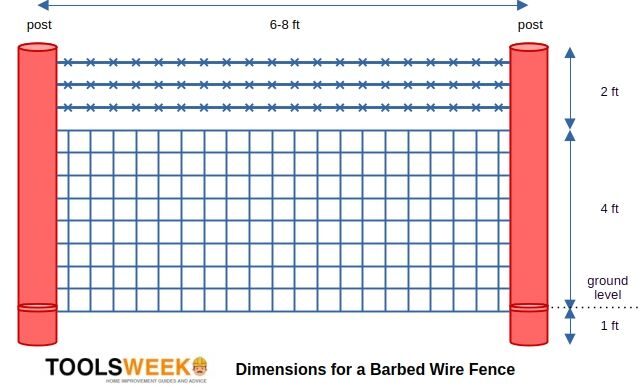
More Recommendations
In addition to the above, I recommend the following:
- Measure the entire perimeter to be covered and plan the layout first before digging.
- Consider using steel posts over wooden ones for greater durability, and use ones at least 2” in diameter. Make it thicker if using wooden posts.
- Place a post in each corner point and additional ones apart over distances longer than 6 to 8 feet.
- Secure each post in a concrete block below the ground, which you should prepare after digging the post holes (not before).
- Put some gravel at the bottom of each post hole (to prevent them from rusting).
- Consider using lumbar for the rails, as they would be easier to work with.
Safety
Barbed wire is very sharp, so you must handle it very carefully.
You can easily injure yourself if you don’t. Other barbed wire accessories I recommend you use are safety tools specifically designed for carrying, handling, and unrolling barbed wire.
I recommend carrying a barbed wire carrier like the one below.
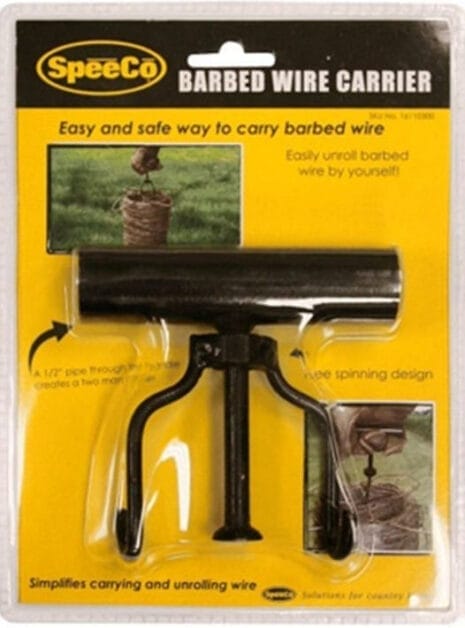
I recommend wearing gloves and using a pipe when unrolling it.
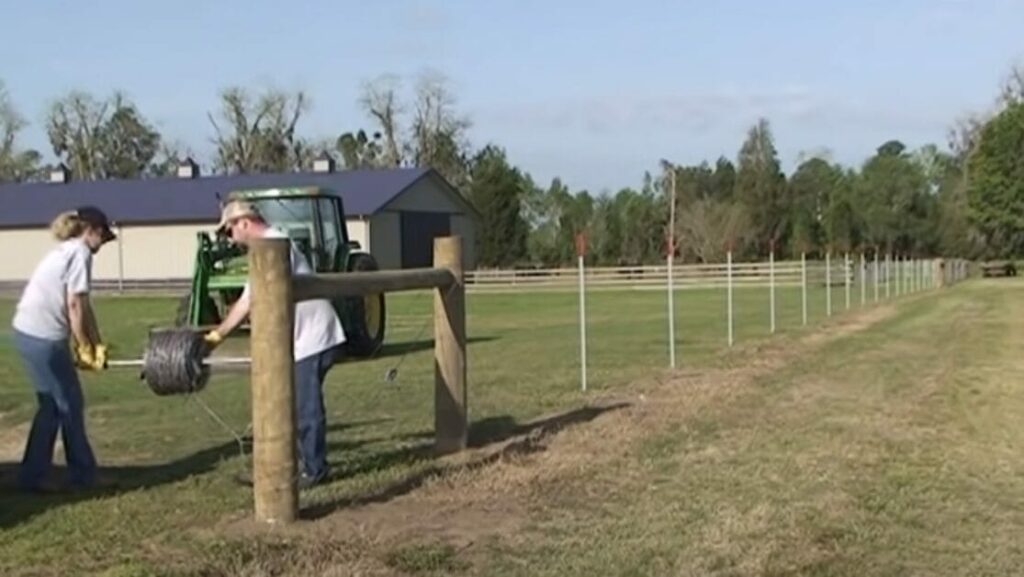
Also, use a wire grab device, called a barbed wire gripper, when pulling the barbed wire.
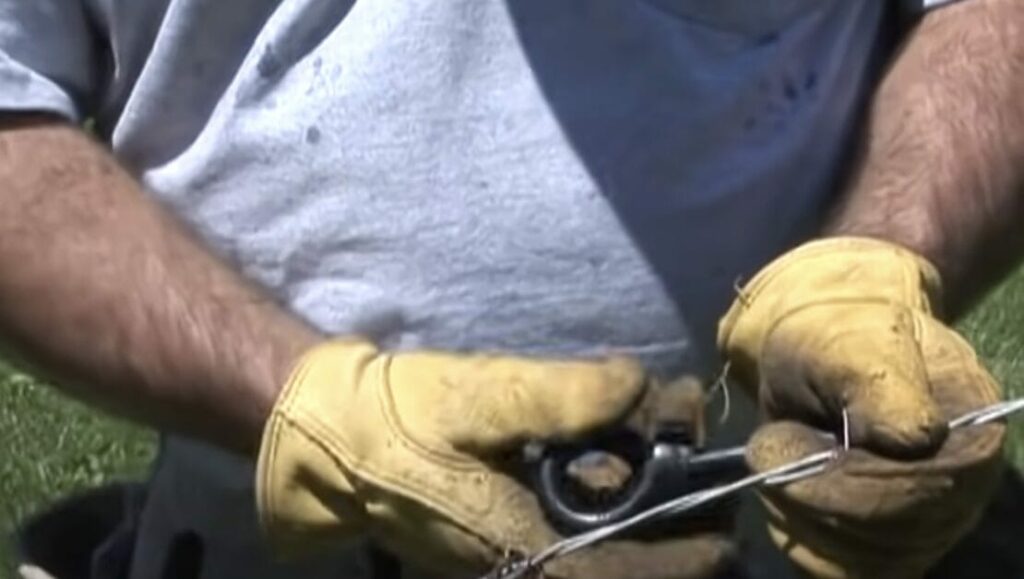
Installing a barbed wire fence may be difficult to do on your own, so having an assistant with you is better.
Procedure for Building a Barbed Wire Fence
The general procedure for building a barbed wire fence involves doing the steps below in the order indicated.
This example uses thick wooden posts at the ends, and thinner metal posts are spaced equally apart.
Step 1: Planning
Plan the layout and determine the precise locations of each post. Have a post in each corner point or where the fence’s direction changes, and additional ones spaced a reasonable distance apart.
Step 2: Digging Holes
Dig holes for all the posts.
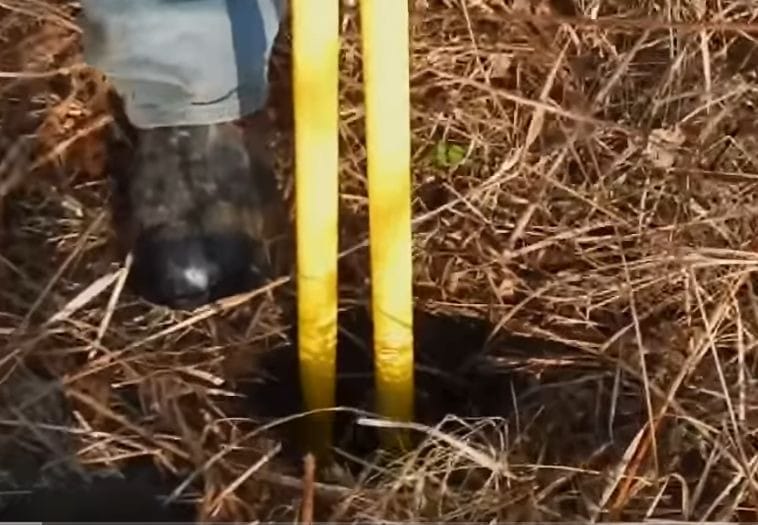
Step 3: Embed each Post
Embed each post in a block of concrete.
You will need to make one block per hole. If you don’t want concrete, use firm tamp dirt, as shown below, but embed each post deeper into the ground.
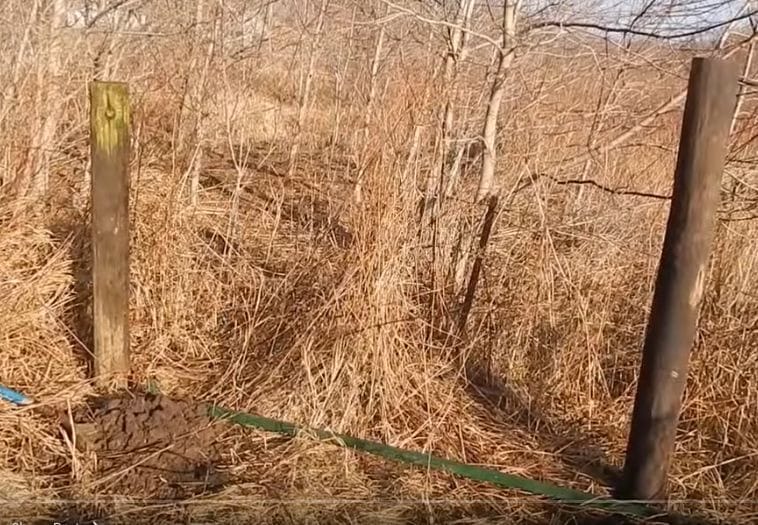
Optionally, use corner braces to provide extra support to hold up the posts, as shown below.
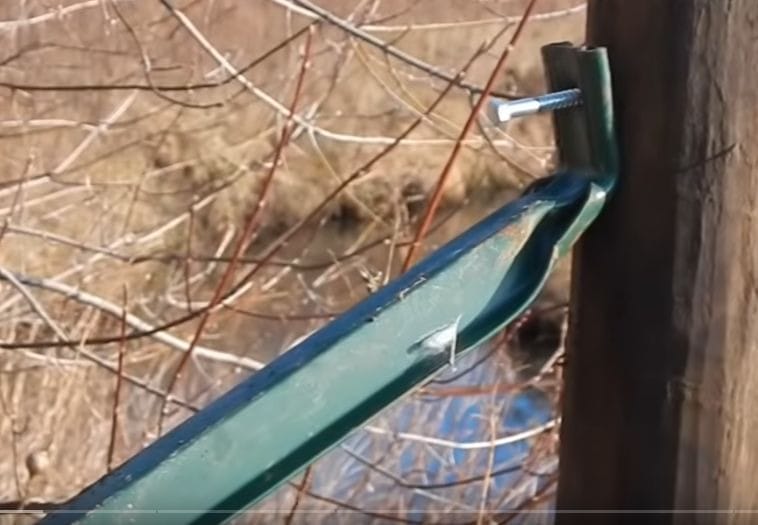
Step 4: Mark Points
Mark points on each post for the barbed wires.
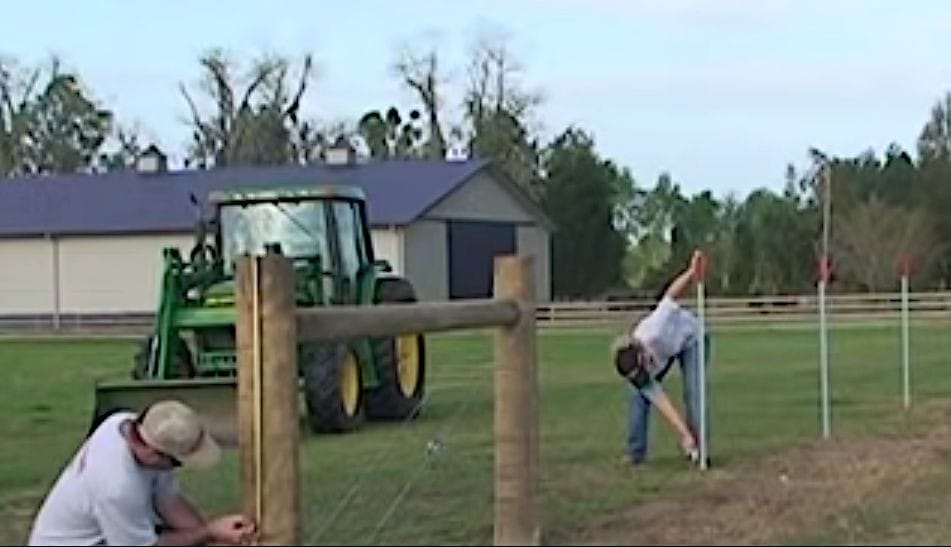
Step 5: Tie the Barbed Wire
Tie the barbed wire around each post.
Optionally, you can embed D-shaped hooks into each post using a hammer. You will use less barbed wire this way.
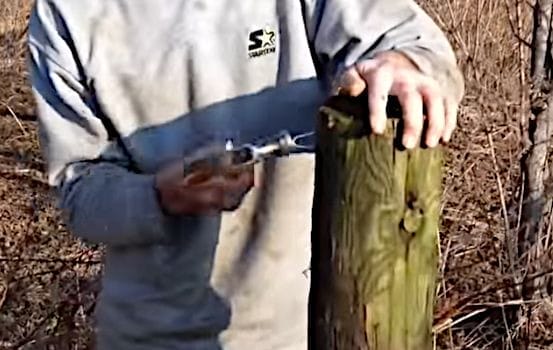
Step 6: Fasten the Barbed Wire
As shown below, fasten the barbed wire around each post by tying it to itself.
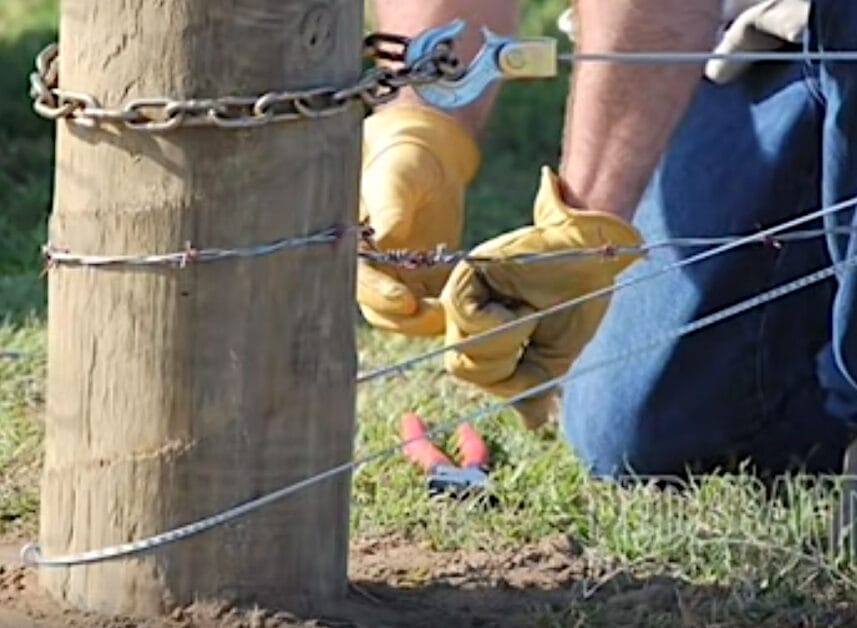
Step 7: Remove Slack
Remove any slack from the unrolled barbed wire. Use a tool such as a hammer to help you do this.
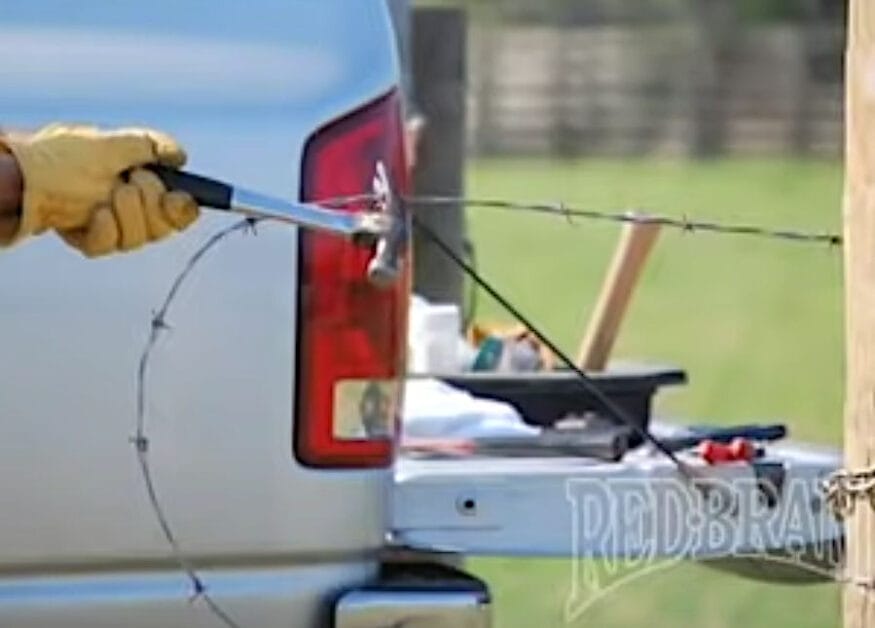
Step 8: Tighten the Barbed Wire
Tighten the barbed wire using a ‘come along’ device, as shown below. Make it taut without over-stretching it.
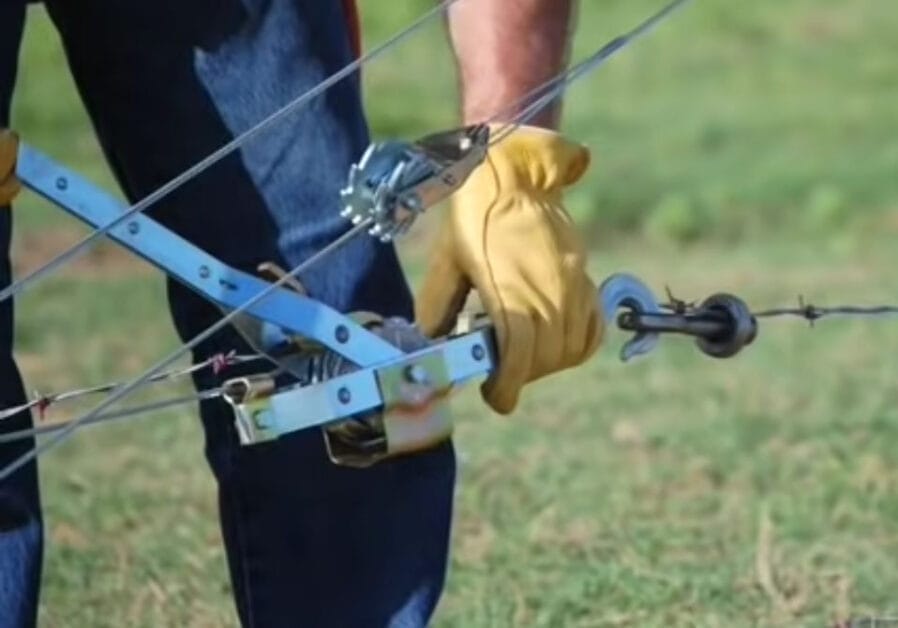
You should have enough wire remaining to wrap it around the final post. I suggest wrapping it around 4 to 5 times to make it secure. Repeat up to the next main post.
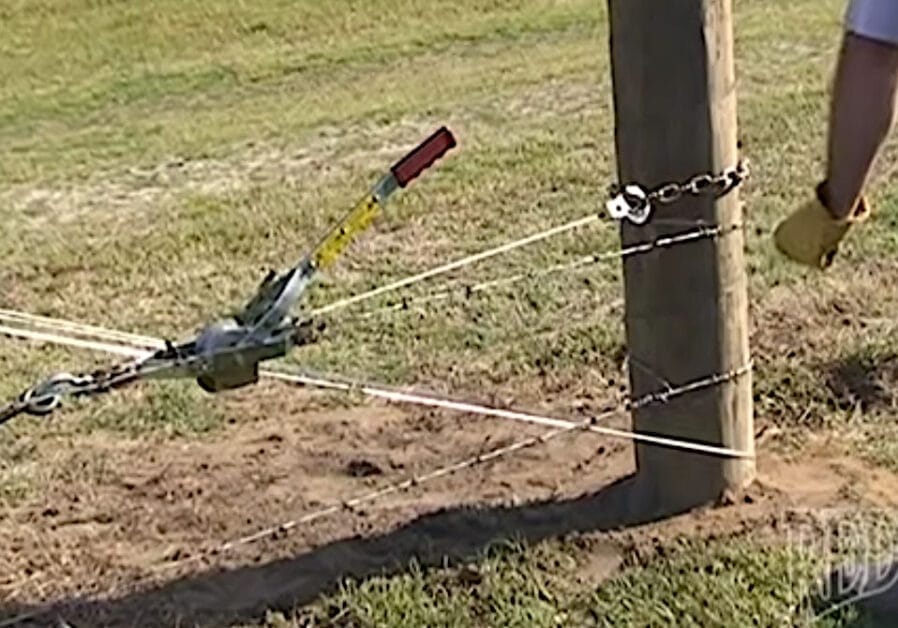
Step 9: Attach to Intermediate Posts
Secure the barbed wire to the intermediate posts.
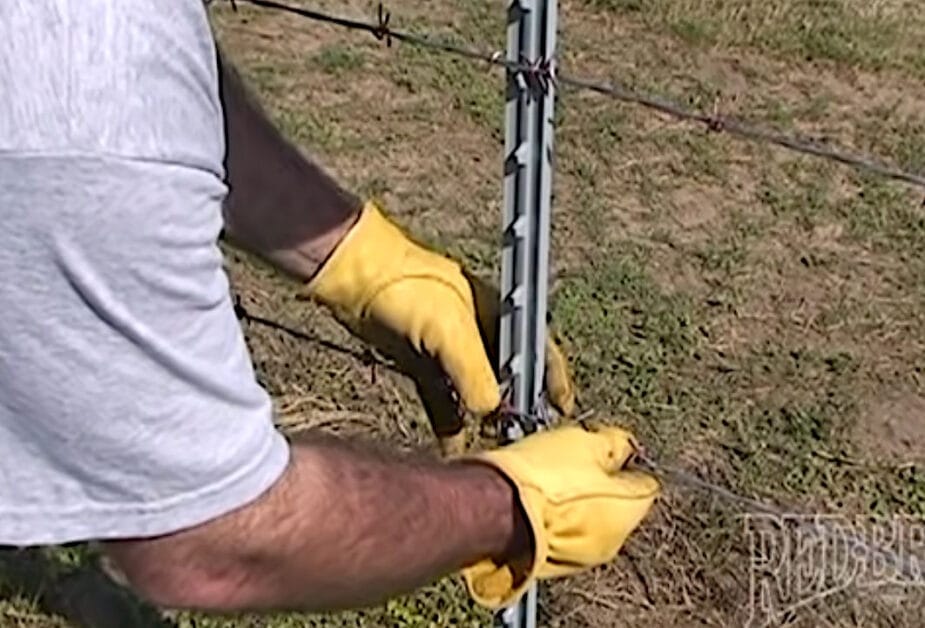
Step 10: Install Fence Rods (Optional)
Optionally, install fence rods vertically between each pair of posts, as shown below. They will make the barbed wires more resistant to being pulled apart.
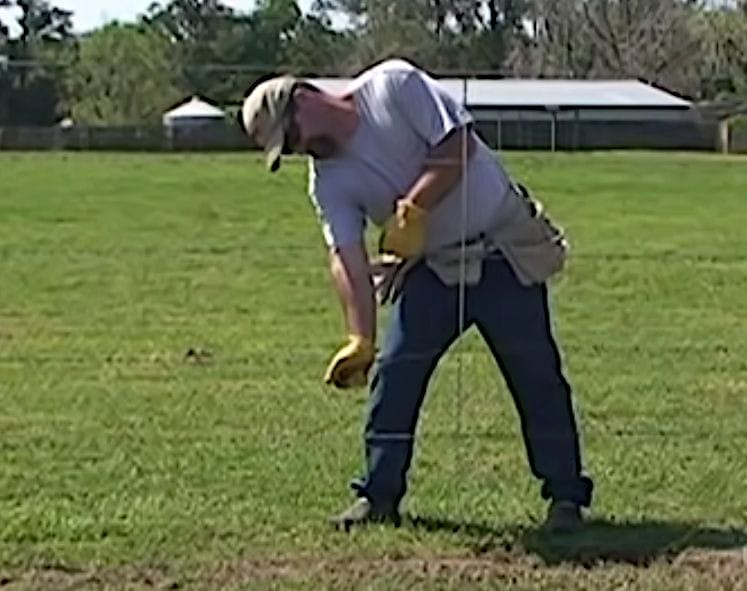
Joining Two Barbed Wires
If you need to join two barbed wires, use crimp sleeves or do it manually.
Using Crimp Sleeves
If you need to join two barbed wire ends, use two or three crimp sleeves and a crimp tool. Place them joined together as shown below before pressing with the crimp tool.

Manually Joining Barbed Wire
The manual method of joining barbed wire will require extra care.
Wrap the wires around each other carefully on both ends until they don’t stick out. The overlap on each end should be at least one foot.
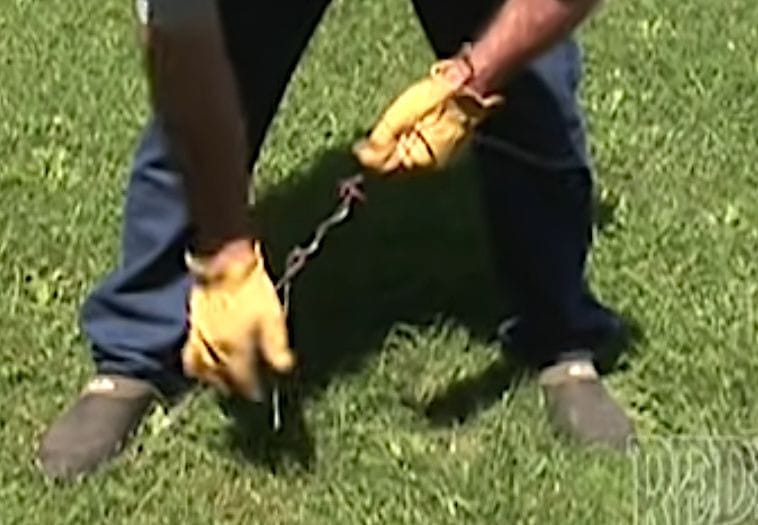
More About Barbed Wire Fences
Why Build Barbed Wire Fences?
Barbed wire fences are less expensive than woven wire and wooden fences.
The cost could make a big difference if, for example, you have a large field or farm to build a fence around. They are ideal for keeping your livestock inside and intruders out.
Uses of Barbed Wire Fences
Common uses of barbed wire fences include:
- Marking property lines
- Securing property from trespassers, intruders, and pests
- Protecting livestock from leaving the area
Using Barbed Wire for Animals
Barbed wire can be either non-electrified or electrified to keep animals inside.
If electrifying them for animals, it may be enough to only electrify the one at their eye level or roughly two-thirds of their height. [Hasheider, 2014]
Bear in mind that many animals get caught on and killed by barbed wire fences. As shown below, you can limit this by covering the top strand with poly pipe pieces.

Safety when Handling Barbed Wire for Fencing
You must be very careful when handling and installing barbed wire because they can do the same damage to you as they can to the animals to keep them inside.
Read the safety section above before building a barbed wire fence.
Barbed Wire Fence Designs
You have a few different design options for building your own barbed wire fence. A few suggestions to inspire you are given below.
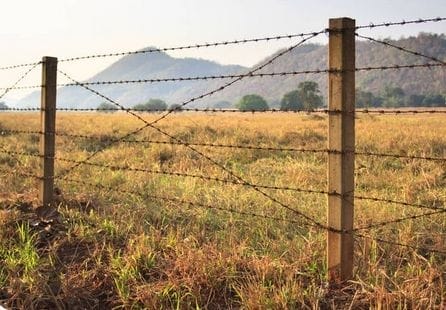
This is a simple barbed wire fence commonly seen on ranches and farms. It combines horizontal and diagonal stretches.
[Pinterest]
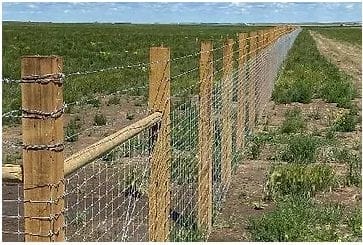
This vertical barbed wire fence combines a meshed wire in the bottom portion with a few strands of barbed wire at the top. It is typically used for farm fencing.
[Lynx Brand]
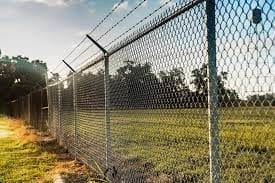
This is similar to the above, except that the barbed wire portion is angled inwards to make it less visible (and ugly) on the outside. You will need to attach barbed wire arms on each post.
[Duraguard Fence Ltd]
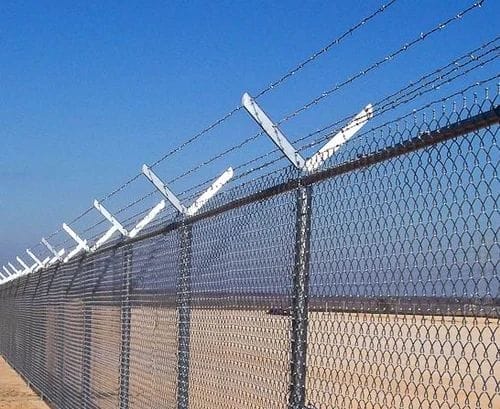
This is a variant of the above in which v-shaped arms have been used. You will need to attach v-shaped barbed wire arms. It is suitable for covering more areas with barbed wire for added security without vertically extending the section.
[India Mart]
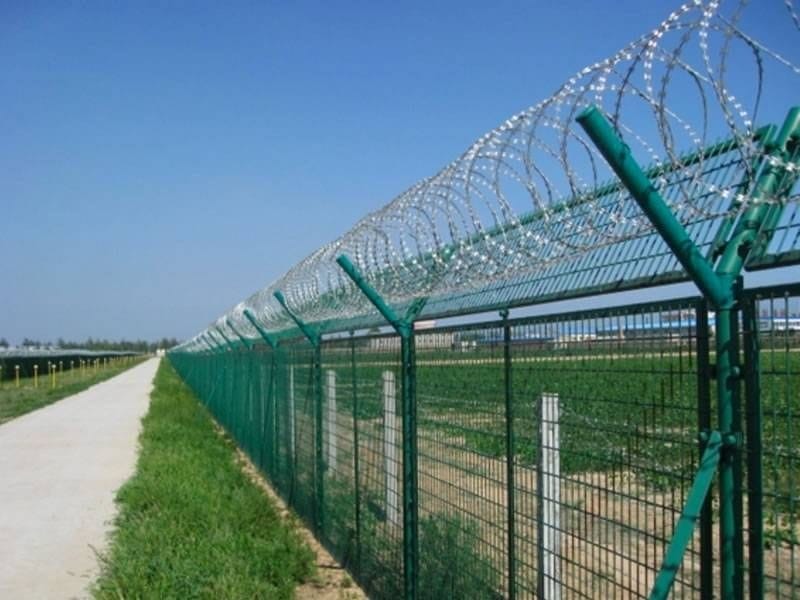
A coiled barbed wire fence will make it even more prohibitive for anyone considering climbing over. It is suitable where security is the key concern.
[Yujun]
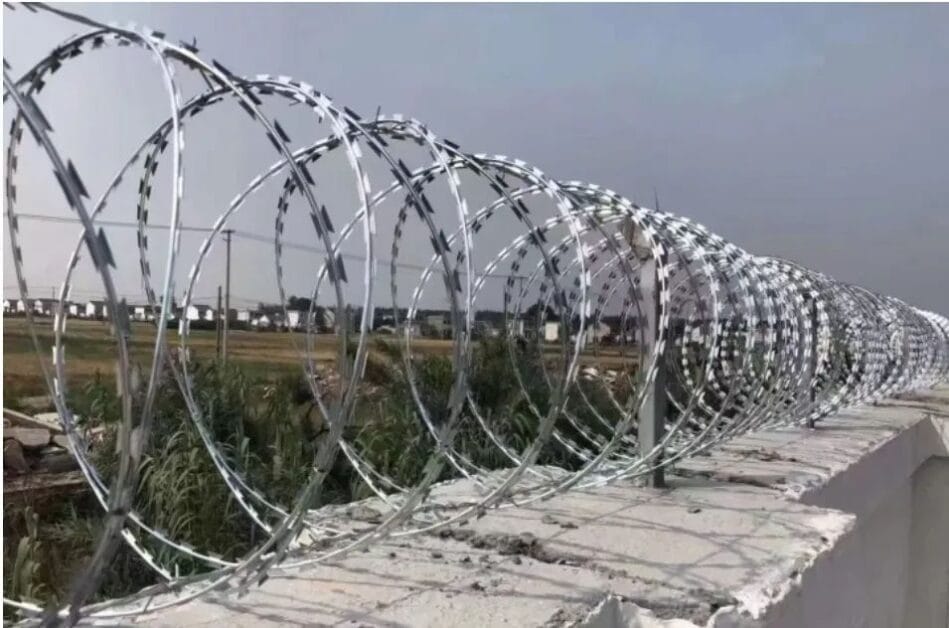
This concertina barbed wire fencing type is more commonly used in highly restricted areas where security is the prime concern. They are considered ugly but can inflict serious injuries, so they do what they are designed for.
[PABMS]
FAQ Section
How Far Apart Should Barbed Wire Fence Posts Be Placed?
Space your fence posts 6 to 8 feet apart for optimal stability and strength. If you’re working with longer sides on your property, you can extend this distance up to 12 to 18 feet, but ensure the posts are buried deeper to accommodate the extra tension.
What Is The Best Type Of Post For A Barbed Wire Fence?
Steel posts offer greater durability and longevity. Choose steel posts with at least a 2-inch diameter for a robust fence. If you prefer wooden posts, select a thicker option to ensure stability and sturdiness.
How Deep Should Fence Posts Be Buried?
For a solid fence, bury the bottom of each post about one foot underground. If you need a more solid footing, especially for taller fences, increase the depth to 2 to 3 feet.
Can Barbed Wire Fences Be Electrified?
Yes, barbed wire fences can be electrified. It’s often enough to electrify just the strand at the animal’s eye level or approximately two-thirds of their height to contain them effectively.
What Safety Equipment Is Recommended When Installing Barbed Wire Fencing?
Always wear thick gloves and use a pipe or a specially designed-carrier to unroll the wire. A wire grab device, such as a barbed wire gripper, is also recommended to safely handle and stretch the barbed wire.
How Do You Join Two Ends Of Barbed Wire Together?
You can use crimp sleeves with a crimp tool to join two barbed wire ends. Alternatively, for a manual join, carefully wrap the ends around each other, ensuring at least one-foot overlap on each end.
What Are The Main Uses Of Barbed Wire Fences?
Barbed wire fences are commonly used to mark property boundaries, protect livestock, secure property against intruders and pests, and generally delineate areas on a farm or ranch.
Is It Possible To Build A Barbed Wire Fence By Myself?
While it is possible to install a barbed wire fence on your own, it’s recommended to have at least one assistant for safety and efficiency.
How Does Barbed Wire Fence Impact Wildlife?
Barbed wire can pose a risk to wildlife, leading to injury or death. To mitigate this, consider covering the top strand with poly pipe pieces to make it more visible to animals.
What Is The Historical Significance Of Barbed Wire Fences?
Barbed wire fences have been crucial in developing agricultural practices in the United States, especially after the Homestead Act of 1862. They allowed for effective and economical fencing of large areas of farmland.
References
Books:
- David B. Lindenmayer, Suzannah M. Macbeth, David G. Smith & Michelle L. Young. https://styluspub.presswarehouse.com/browse/author/80e6a9da-d58b-474b-a80a-ac1d84502c64/Lindenmayer-David-B
- Joanne S. Liu. Barbed wire: The fence that changed the west. https://www.abebooks.com/9780878425570/Barbed-Wire-Fence-Changed-West-0878425578/plp
- Philip Hasheider. How to raise pigs: everything you need to know. Voyageur Press. https://www.abebooks.com/Raise-Pigs-Everything-Need-Know-FFA/31390002285/bd
Website Resources:
- Agri Supply. https://www.agrisupply.com/barbed-wire-carrier/p/75034/#mz-expanded-view-1117883994728.
- Duraguard Fence Ltd. https://www.duraguardfence.ca/post/when-to-add-barbed-wire-to-your-commercial-fencing
- Fence-Material.com. https://fence-material.com/1-fence-parts-vinyl-parts-railing-canop/barb-wire-arms-barb-wire-hangers/
- India Mart. https://m.indiamart.com/proddetail/barbed-wire-fence-4785053297.html
- Lynx Brand. https://www.lynxfence.com/post/types-of-farm-fencing-and-what-theyre-used-for
- PABMS. https://www.progressabms.sg/concertina-wire/
- Pinterest. https://www.pinterest.com/pin/211106301263437678/
- Yujun. https://www.razorbarbedwirefence.com/razorbarbedwirefence/products-index.html
Video References:
Farmcards
Red Brand
